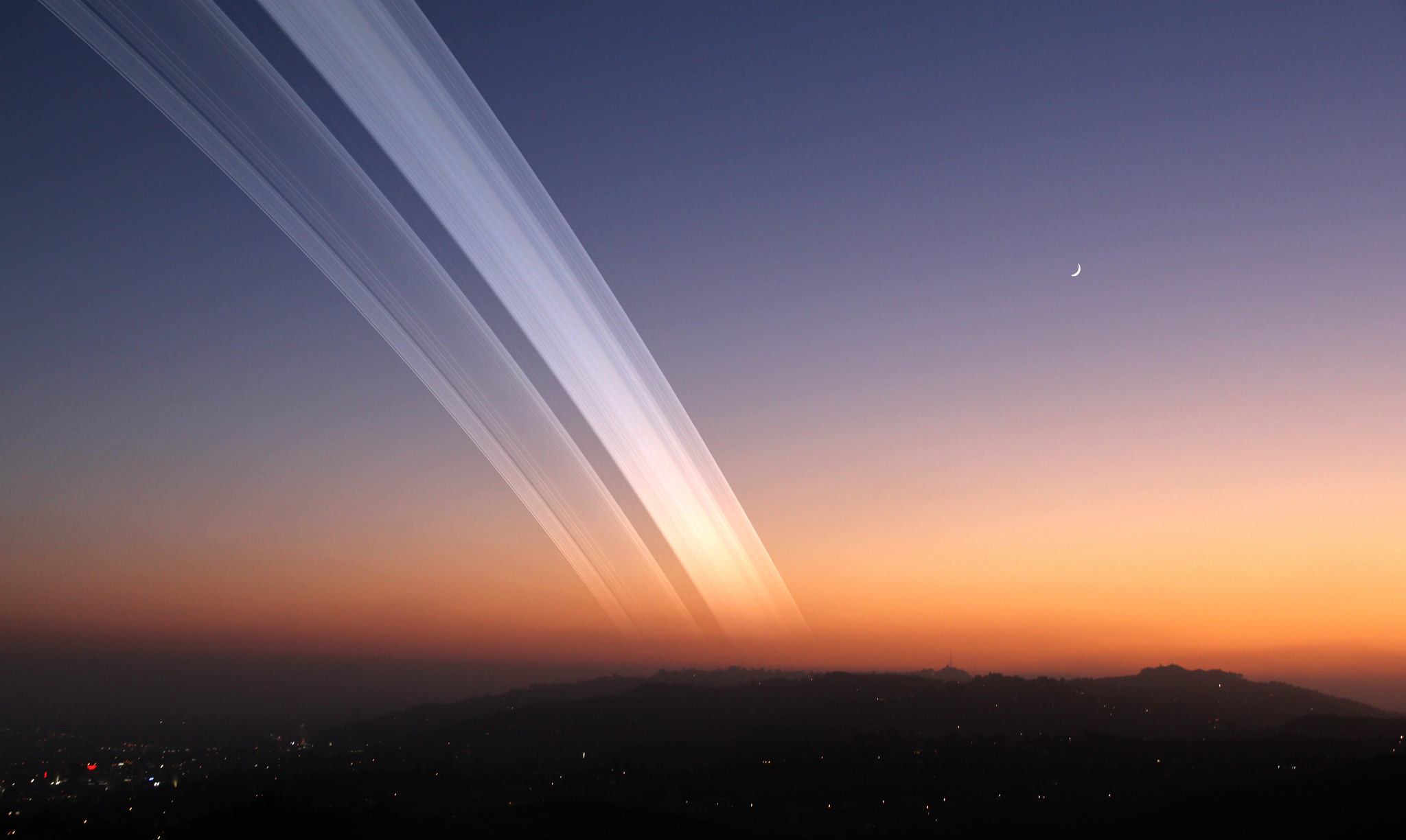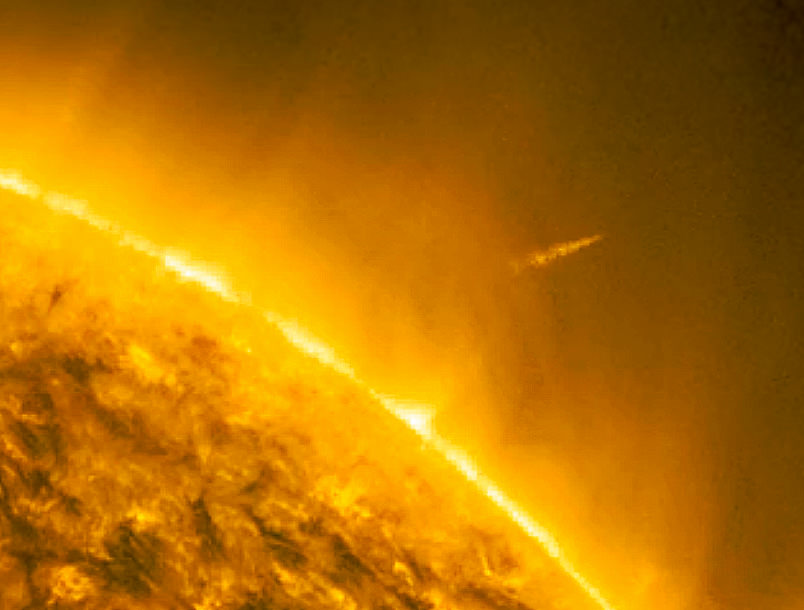Astronomers have confirmed the existence of exoplanets with extremely small orbits around their stars. But what about exoplanets that get close enough to be devoured by their star, and what if it’s an Earth-sized exoplanet? This is what a recent study accepted to AAS Journals hopes to address as an international team of more than 50 researchers investigated an Earth-sized exoplanet with an orbital period of only 5.7 hours, known as “ultra-short-period” (USP) exoplanets, that could eventually experience what’s known as tidal disruption, resulting in its devourment by its star. This study holds the potential to help researchers better understand the processes responsible for this, along with continuing to challenge our understanding of exoplanetary architectures, as well.
Continue reading “Good Thing We Found this Earth-Sized Planet Now. It’s About to Be Destroyed”Dwarf Planet Quaoar has a Ring
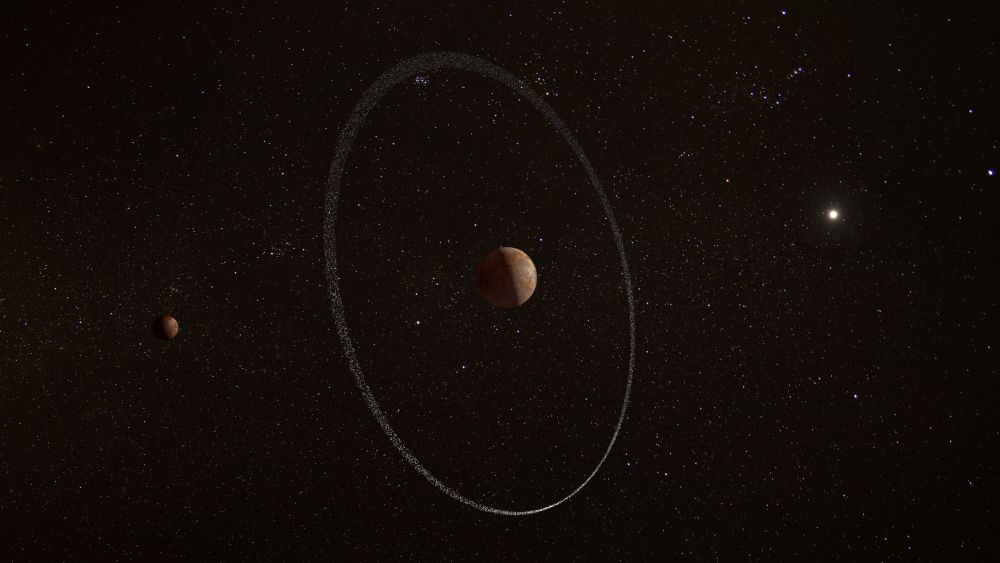
Quaoar is one of about 3,000 dwarf planets in our Solar System’s Kuiper Belt. Astronomers discovered it in 2002. It’s only half as large as Pluto, about 1,121 km (697 mi) in diameter. Quaoar has a tiny moon named Weywot, and the planet and its moon are very difficult to observe in detail.
Astronomers took advantage of an occultation to study the dwarf planet Quaoar and found that it has something unexpected: a ring where a moon should be.
Continue reading “Dwarf Planet Quaoar has a Ring”How Close Can Moons Orbit?
The Moon is great and all, but I wish it was closer. Close enough that I could see all kinds of detail on its surface without a telescope or a pair of binoculars. Close enough that I could just reach up and grab enough cheese for a lifetime of grilled cheese sandwiches.
Sure, there would be all kinds of horrible problems with having the Moon that much closer. Intense tides, a total lack of good dark nights for stargazing, and something else… Oh right, the total destruction of life on Earth. On second thought the Moon can stay right where it is, thank you very much.
The Earth’s Moon is located an average distance of 384,400 kilometers away. I say average because the Moon actually follows an elliptical orbit. At its closest point, it’s only 362,600 km, and at its furthest point, it’s 405,400 kilometers.
Still, that’s so far that it takes light a little over a second to reach the Moon, traveling almost 300,000 km/s. The Moon is far.
But what if the Moon was much closer? How close could it get and still be the Moon?
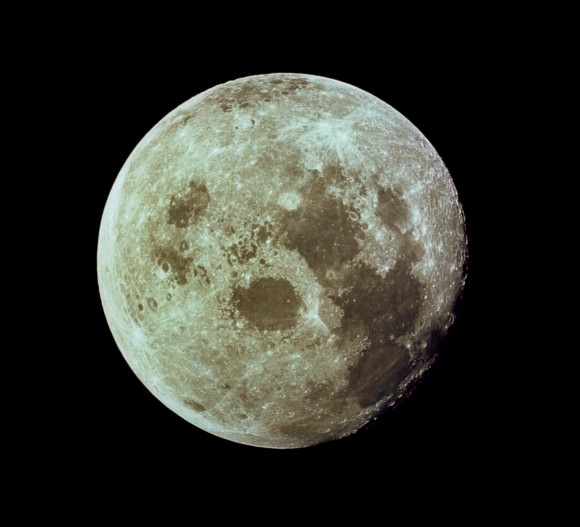
Once again, I need to remind you that this is purely theoretical. The Moon isn’t getting closer to us, in fact, it’s getting further. The Moon is slowly drifting away from us at a distance of almost 4 centimeters per year.
Let’s go back to the beginning, when the young Earth collided with a Mars-sized planet billions of years ago. This catastrophic encounter completely resurfaced planet Earth, and kicked up a massive amount of debris into orbit. Well, a Moon’s worth of debris, which collected together by mutual gravity into the roughly spherical Moon we recognize today.
Shortly after its formation, the Moon was much closer, and the Earth was spinning more rapidly. A day on Earth was only 6 hours long, and the Moon took just 17 days to orbit the Earth.
The Earth’s gravity stopped the Moon’s relative rotation, and the Moon’s gravity has been slowing the Earth’s rotation. To maintain the overall angular momentum of the system, the Moon has been drifting away to compensate.
This conservation of momentum is very important because it works both ways. As long as a moon takes longer than a day to orbit its planet, you’re going to see this same effect. The planet’s rotation slows, and the moon drifts further to compensate.
But if you have a scenario where the moon orbits faster than the planet rotates, you have the exact opposite situation. The moon makes the planet rotate more quickly, and it drifts closer to compensate. This can’t end well.
Once you get close enough, gravity becomes a harsh mistress.
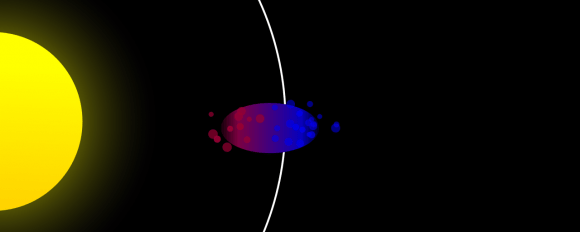
There’s a point in all gravitational interactions called the Roche Limit. This is the point at which an object held together by gravity (like the Moon), gets close enough to another celestial body that it gets torn apart.
The exact point depends on the mass, size and density of the two objects. For example, the Roche Limit between the Earth and the Moon is about 9,500 kilometers, assuming the Moon is a solid ball. In other words, if the Moon gets within 9,500 kilometers or so, of the Earth, the gravity of the Earth overwhelms the gravity holding the Moon together.
The Moon would be torn apart, and turned into a ring. And then the pieces of the ring would continue to orbit the Earth until they all came crashing down. When that happened, it would be a series of very bad days for anyone living on Earth.
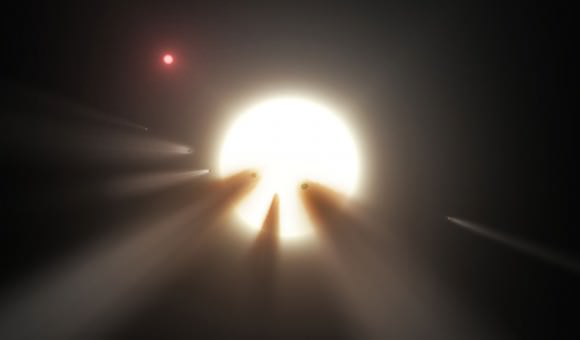
If an average comet got within about 18,000 km of Earth, it would get torn to pieces. While the Sun can, and does, tear apart comets from about 1.3 million km away.
This sounds purely theoretical, but this is actually going to happen over at Mars. Its largest moon Phobos orbits more quickly than a Martian day, which means that it’s drifting closer and closer to the planet. In a few million years, it’ll cross the Roche Limit, tear into a ring, and then all the pieces of the former Phobos will crash down onto Mars. We did a whole article on this.

Now you might be wondering, wait a second. I’m a separate object from the Earth, why don’t I get torn apart since I’m definitely within the Earth’s Roche Limit.
You do have gravity holding you together, but it’s insignificant compared to the chemical bonds holding you together. This is why physicists consider gravity to actually be a pretty weak force compared to all the other forces of the Universe.
You’d need to go somewhere with really intense gravity, like a black hole, for the Roche Limit to overcome the forces holding you together.
So that’s it. Bring the Moon within 9,500 kilometers or so and it would no longer be a Moon. It would be torn apart into a ring, a Halo ring, if you will, capable of wiping out all life on a planet infected by the flood. All the moons we see in the Solar System are are least at the Roche Limit or beyond, otherwise they would have broken up long ago… and probably did.
What Would Earth Look Like With Rings?
Saturn’s Rings are amazing to behold. Since they were first observed by Galileo in 1610, they have been the subject of endless scientific interest and popular fascination. Composed of billions of particles of dust and ice, these rings span a distance of about 282,000 km (175,000 miles) – which is three quarters of the distance between the Earth and its Moon – and hold roughly 30 quintillion kilograms (that’s 3.0. x 1018 kg) worth of matter.
All of the Solar System’s gas giants, from Jupiter to Neptune, have their own ring system – albeit less visible and picturesque ones. Sadly, none of the terrestrial planets (i.e. Mercury, Venus, Earth and Mars) have such a system. But just what would it look like if Earth did? Putting aside the physical requirements that it would take for a ring system to exist, what would it be like to look up from Earth and see beautiful rings reaching overhead?
How Could We Destroy the Moon?
What would it take to destroy our moon, and eliminate the enemy of stellar astronomy for all time?
In the immortal words of Mr. Burns, “ever since the beginning of time, man has wished to destroy the Sun.” Your days are numbered, Sun.
But supervillains, being the practical folks they are, know that a more worthy goal would be to destroy the Moon, or at least deface it horribly. Nothing wrecks a beautiful night sky like that hideous pockmarked spotlight. What would it take to destroy it and eliminate the enemy of stellar astronomy for all time?
Crack out your Acme brand blueprint paper and white pencils, it’s Wile E. Coyote time.
The energy it takes to dismantle a gravitationally held object is known as its binding energy, we talked about it in a Death Star episode and inventive ways to overcome it.
For example, the binding energy of the Earth is 2.2 x 10^32 joules. It’s a lot. The binding energy of a smaller object, like our Moon is a tidy little 1.2 x 10^29 joules. It takes about 1800 times more energy to destroy the Earth than it takes to destroy the Moon.
It’s 1800 times easier. That’s downright doable, isn’t it? That’s almost 2000 times easier. Which, on the scale of easy to less easy, is definitely closer to easy.
Take the event that created the Caloris Basin on Mercury. It’s a crater, 1,500 km across. Astronomers think that a big fat asteroid, a fatsteroid(?) around 100 km in diameter crashed into Mercury billions of years ago. This event released 1.3 x 10^26 joules of energy, carving out this giant pit. It’s a thousandth of the binding energy of the Moon. We’ll need something more.
Our Sun produces 3.8 x 10^26 joules of energy every second, the equivalent of about a billion hydrogen bombs. If you directed the full power of the Sun at the Moon for 15 minutes, it’d tear apart.
That’s quite a superweapon you’ve got there, perhaps you’ll want to mount that on a space station and take it for a cruise through a galaxy far far away?
If that scene took that long, we’d have fallen asleep. It’s as if millions of voices gradually became a little hoarse from crying out for a quarter of an hour. There’s another way you could tear the Moon apart that doesn’t require an astral gate accident: gravity.
Astronomers use the Roche Limit to calculate how close an object – like a moon – can orbit another object – like a planet.
This is the point where the difference between the tidal forces on the “front” and “backside” are large enough that the object is torn apart, and if this sounds familiar you might want to look up “spaghettification”.

This is all based on the radius of the planet and the density of the planet and moon. If the Moon got close enough to the Earth, around 18,000 km, it would pull apart and be shredded into a beautiful ring.
And then the objects in the ring would enter the Earth’s atmosphere and rain down beautiful destruction for thousands of years.
Fortunately or unfortunately, depending your position in this “Die Moon, Die” discussion, the Moon is drifting away from the Earth. It’ll never be closer than it is right now, at almost 400,000 km, without a little nudge.
Phobos, the largest moon orbiting Mars is slowly approaching the planet, and astronomers think it’ll reach the Roche Limit in the next few million years.
It turns out that if we really want to destroy the Moon, we’ll need to destroy all life on Earth as well.
Now we know your new supervillain project, what’s your supervillain name? Tell us your handle in the comments below.
Bumper Car Moonlets Crash and Crumble in Saturn’s F Ring
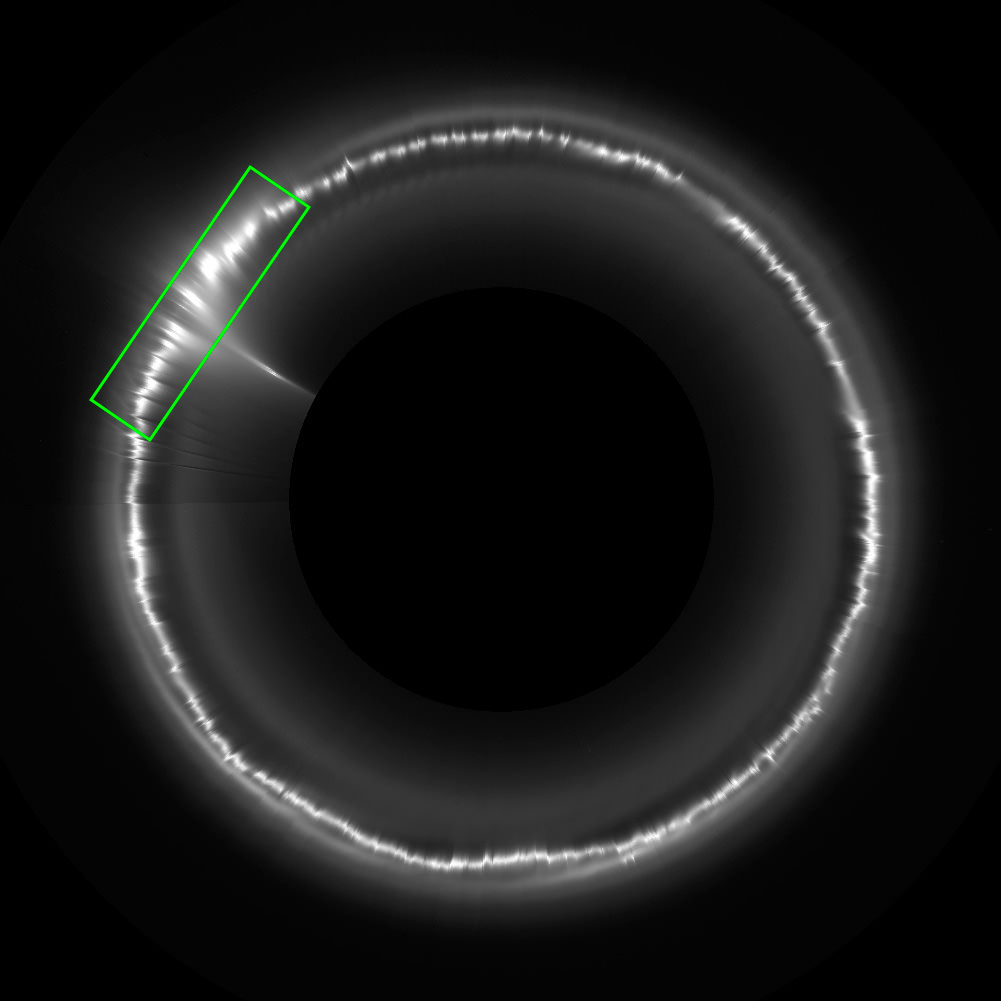
Nothing stands still. Everything evolves. So why shouldn’t Saturn’s kookie, clumpy F ring put on a new face from time to time?
A recent NASA-funded study compared the F ring’s appearance in six years of observations by the Cassini mission to its appearance during the Saturn flybys of NASA’s Voyager mission, 30 years earlier.
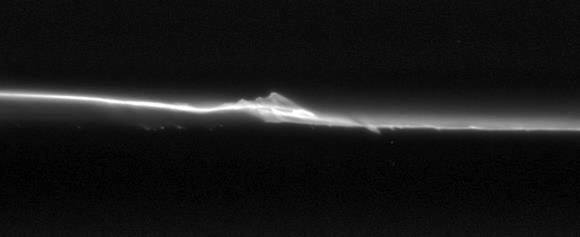
While the F ring has always displayed clumps of icy matter, the study team found that the number of bright clumps has nose-dived since the Voyager space probes saw them routinely during their brief flybys 30 years ago. Cassini spied only two of the features during a six-year period.
Scientists have long suspected that moonlets up to 3 miles (5 km) wide hiding in the F ring are responsible for its uneven texture. Kinks and knots appear and disappear within months compared to the years of observation needed changes in many of the other rings.
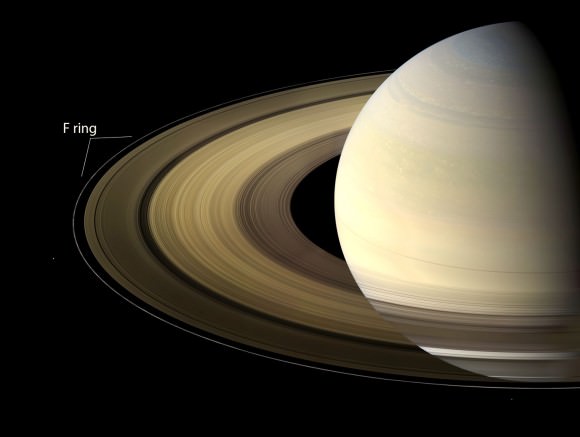
“Saturn’s F ring looks fundamentally different from the time of Voyager to the Cassini era,” said Robert French of the SETI Institute in Mountain View, California, who led the study along with SETI Principal Investigator Mark Showalter. “It makes for an irresistible mystery for us to investigate.”
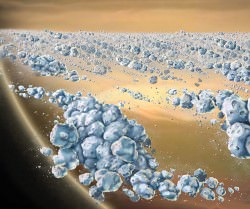
Because the moonlets lie close to the ring and cross through it every orbit, the research team hypothesizes that the clumps are created when they crash into and pulverize smaller ring particles during each pass. They suspect that the decline in the number of exceptionally bright kinks and the clumps echoes a decline in the number of moonlets available to do the job.
So what happened between Voyager and Cassini? Blame it on Prometheus. The F ring circles Saturn at a delicate point called the Roche Limit. Any moons orbiting closer than the limit would be torn apart by Saturn’s gravitational force.
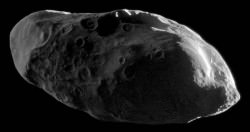
“Material at this distance from Saturn can’t decide whether it wants to remain as a ring or coalesce to form a moon,” said French. “Prometheus orbits just inside the F ring, and adds to the pandemonium by stirring up the ring particles, sometimes leading to the creation of moonlets, and sometimes leading to their destruction.”
Every 17 years the orbit of Prometheus aligns with the orbit of the F ring in a way that enhances its gravitational influence. The researchers think the alignment spurs the creation of lots of extra moonlets which then go crashing into the ring, creating bright clumps of material as they smash themselves to bits against other ring material.
Sounds like a terrifying version of carnival bumper cars. In this scenario, the number of moonlets would gradually drop off until another favorable Prometheus alignment.
The Voyagers encounters with Saturn occurred a few years after the 1975 alignment between Prometheus and the F ring, and Cassini was present for the 2009 alignment. Assuming Prometheus has been “working” to build new moons since 2009, we should see the F ring light up once again with bright clumps in the next couple years.
Cassini will be watching.
How Did Comet Lovejoy Survive Its Trip Around The Sun?
[/caption]
It was just about three months ago that the astronomy world watched in awe as the recently-discovered comet Lovejoy plummeted toward the Sun on what was expected to be its final voyage, only to reappear on the other side seemingly unscathed! Surviving its solar visit, Lovejoy headed back out into the solar system, displaying a brand-new tail for skywatchers in southern parts of the world (and for a few select viewers above the world as well.)
How did a loosely-packed ball of ice and rock manage to withstand such a close pass through the Sun’s blazing corona, when all expectations were that it would disintegrate and fizzle away? A few researchers from Germany have an idea.
Scientists from the Max Planck Institute for Extraterrestrial Physics and the Braunschweig University of Technology have hypothesized that Comet Lovejoy managed to hold itself together through the very process that, to most people, defines a comet: the outgassing of sublimated icy material.
As a comet near the Sun, the increased heating from solar radiation causes the frozen materials within the nucleus to sublimate — go directly and suddenly from solid to gas, skipping the liquid middle stage — and, in doing so, burst through the surface of the comet and create the long, hazy reflective tail that is so often associated with them.
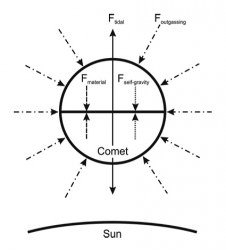
In the case of Lovejoy, which was on a direct path toward the Sun, the sublimation itself may have provided enough outward force across its surface to literally keep it together, according to the team’s research.
“The reaction force caused by the strong outgassing (sublimation) of the nucleus near the Sun acts to keep the nucleus together and to overcome the tidal disruption,” the paper claims.
In addition, the team states that the size of the comet’s nucleus can be derived using an equation that takes into consideration the combined forces of outgassing, the material composition of the comet’s nucleus, the comet’s own gravity and the tidal forces exerted by the comet’s close proximity to the Sun (i.e., the Roche limit).
Using that equation, the team concluded that the diameter of Comet Lovejoy’s nucleus is anywhere between 0.2 km and 11 km (.125 miles and 6.8 miles). Any smaller and it would have lost too much material during its pass (and had too little gravity); any larger and it would have been too thick for outgassing to provide enough counterbalancing force.
If this hypothesis is correct, taking a trip around the Sun may not mean the end for all comets… at least not those of a certain size!
Watch the video of Lovejoy’s Dec. 15 solar swing below:
The paper was submitted to the journal Icarus on March 8, 2012 by Bastian Gundlach. See the full text here.



